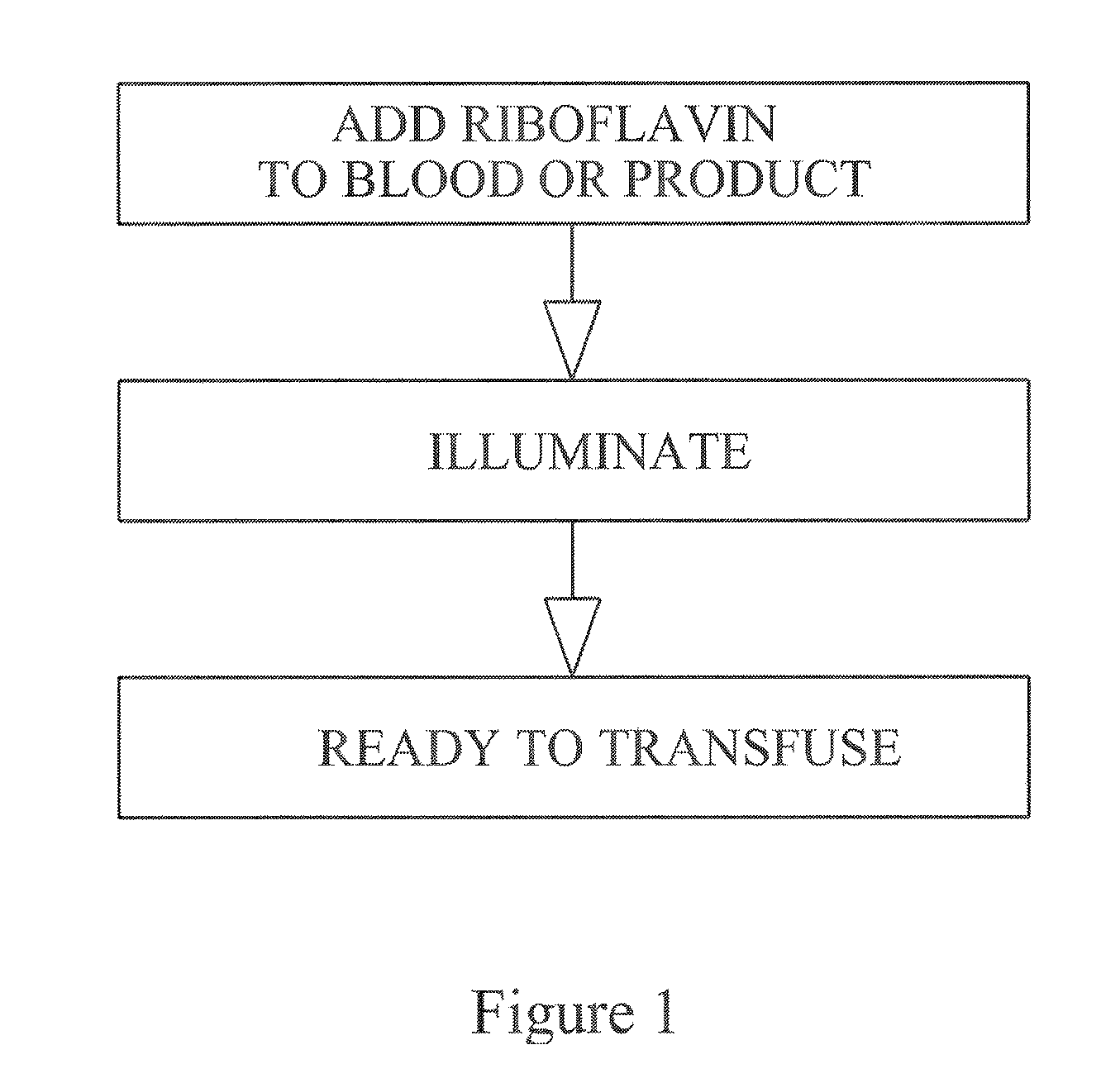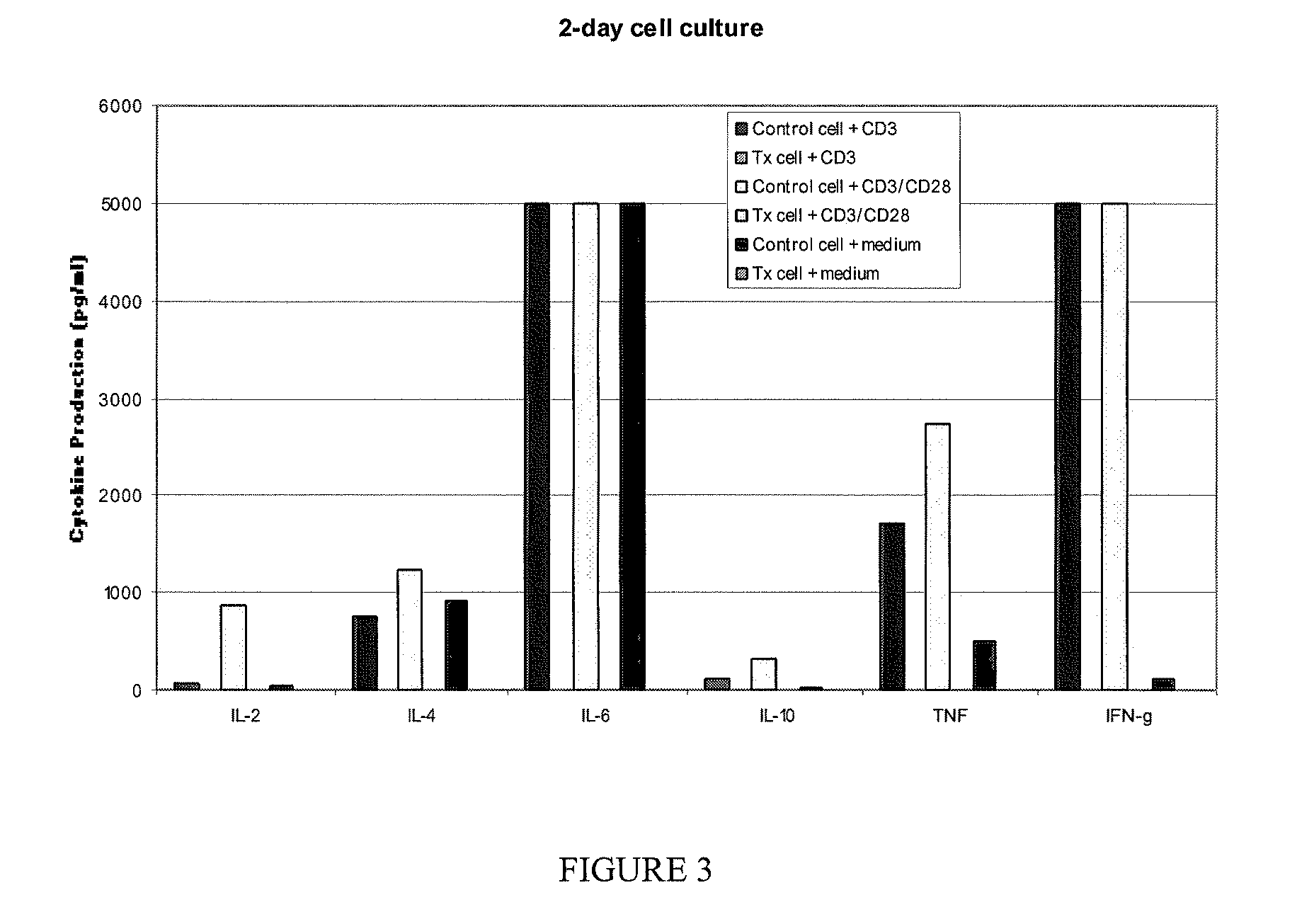Preventing transfusion related complications in a recipient of a blood transfusion
a blood transfusion and recipient technology, applied in the field of methods, can solve the problems of severe risk of bleeding to death, recipients of blood products, and undesirable contamination of cells, and achieve the effect of reducing transfusion related complications
- Summary
- Abstract
- Description
- Claims
- Application Information
AI Technical Summary
Benefits of technology
Problems solved by technology
Method used
Image
Examples
example 1
[0032]The intent of this study was to determine whether human peripheral blood mononuclear cells (PBMNCs) treated with riboflavin and light (hereinafter known as treated cells) could be induced to proliferate in vitro when exposed to a growth stimulus, or whether the treated cells were rendered inactive by the treatment, and therefore could not be induced to proliferate. Untreated cells (control) are those human PBMNCs not treated with riboflavin and light.
[0033]For this study, PBMNC were obtained from three human donors, with each donor set being split into a treated and untreated subset. Each subset was subsequently tested using the in vitro test methods described below. PBMNC were isolated from platelets obtained from the donors using a standard apheresis procedure on a Trima® apheresis machine (available from Gambro BCT, Lakewood, Colo., USA). For treatment with riboflavin and light, the cells were added to ABO-matched platelet-poor plasma (PPP), which was then mixed with ribofl...
example 2
2. A. The Ability of Treated or Untreated PBMNC to be Activated in Response to PMA
[0038]Phorbol myristic acetate (PMA) is a stimulus that activates WBCs but does not cause proliferation. One of the results of this activation signal is the upregulation onto the surface of the leukocyte the activation antigen CD69. Activation through CD69 does not cause the cell to proliferate. This assay determined whether treatment with riboflavin and light interferes with the ability of the cells to be activated.
[0039]As above, WBC were obtained from the leukocyte reduction chamber of a Trima® machine following a double unit platelet collection. The peripheral blood mononuclear cells (PBMNCs) were purified by Ficoll-Hypaque discontinuous gradient centrifugation. These PBMNCs were divided into 2 aliquots and one aliquot was placed in an Extended Life Platelet (ELP) bag containing autologous human plasma and exposed to riboflavin and light. Following the treatment, the PBMNC were collected by centrif...
example 3
[0052]While the results obtained using the in vitro assays above demonstrate that treatment with riboflavin and light inactivates the treated PBMNC, it remains important to confirm these results with an assay that measures the in vivo responsiveness of the treated or untreated PBMNC. One such assay is to measure xenogeneic GVHD responses in mice which have been transfused with human PBMNCs. These mice (Rag− / −γc− / − double knockout mice) lack T and B lymphocytes as well as natural killer (NK) cells, and previous studies have shown that the injection of human WBC into these mice results in xenogeneic GVHD that is characterized by xenoreactive T cells.
Characterization of Donor Cells
[0053]White blood cells were obtained from the leukocyte reduction chamber of a Trima® machine following platelet donation from 6 different human donors. The cells were separated into the mononuclear cell fraction using Ficoll-Hypaque discontinuous centrifugation and then placed in a platelet bag containing a...
PUM
| Property | Measurement | Unit |
|---|---|---|
| wavelength | aaaaa | aaaaa |
| volumes | aaaaa | aaaaa |
| concentration | aaaaa | aaaaa |
Abstract
Description
Claims
Application Information
 Login to View More
Login to View More - R&D
- Intellectual Property
- Life Sciences
- Materials
- Tech Scout
- Unparalleled Data Quality
- Higher Quality Content
- 60% Fewer Hallucinations
Browse by: Latest US Patents, China's latest patents, Technical Efficacy Thesaurus, Application Domain, Technology Topic, Popular Technical Reports.
© 2025 PatSnap. All rights reserved.Legal|Privacy policy|Modern Slavery Act Transparency Statement|Sitemap|About US| Contact US: help@patsnap.com



